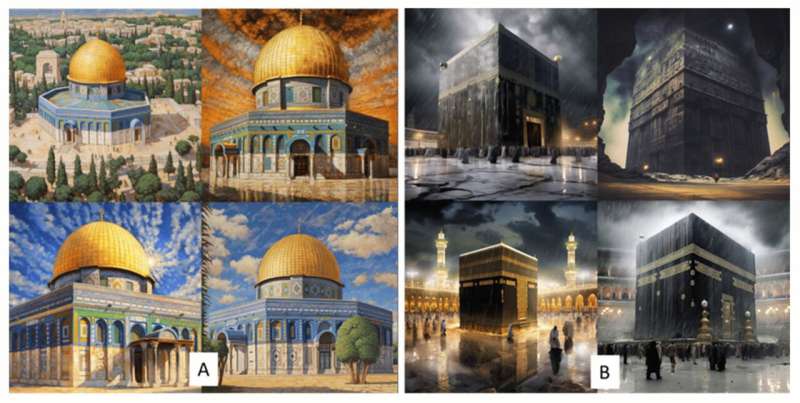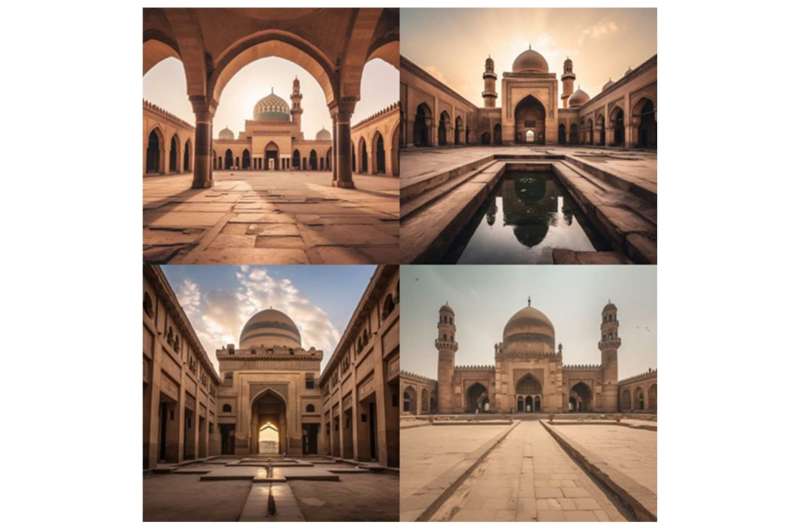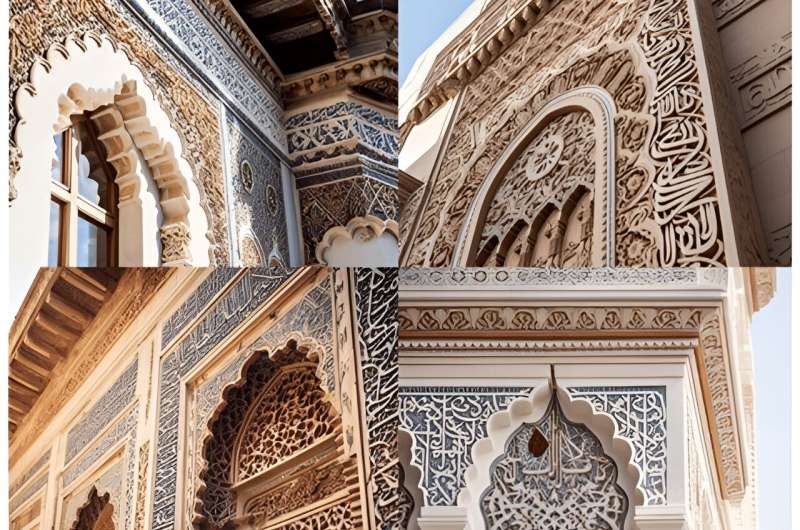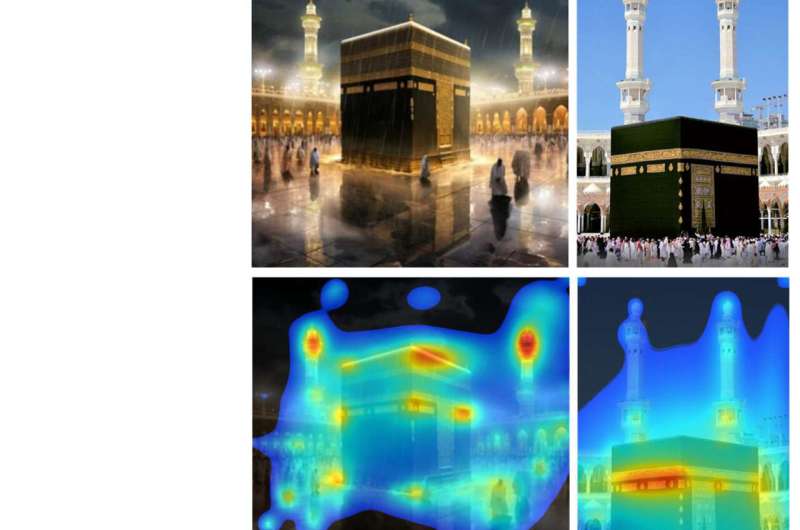
Images generated by Artificial Intelligence (AI) have revolutionized architectural design processes, offering architects the agility to produce highly sophisticated and imaginative designs.
However, in spheres immersed with culture, sensitivity and religion as in the case of Islamic architecture, AI-generated depictions usually fail to correctly present the nuanced understanding of historical Islamic elements and their interpretations, according to research published in the journal Buildings.
“In recent years, the widespread adoption of AI-image generators like Stable Diffusion and Midjourney have revolutionized architectural design processes, offering architects the ability to produce sophisticated and imaginative designs,” says the research’s main author Dr. Ahmad W. Sukkar, a scientist at Sharjah University’s Department of Architectural Engineering.
However, and despite AI’s potential for innovative design outcomes, “many examples found online reveal a blending of limited historical knowledge with inadequacies in the datasets used by AI image generators. In fields as culturally and historically sensitive as Islamic architecture, the integration of AI technology requires careful consideration.”
AI models like Stable Diffusion and Midjourney claim to excel in creating artistic and architectural images and designs with nuanced qualities rich in texture and detail in addition to their ability to create stylized content and realistic visual imagery. They assist artists and architects to produce unique photorealistic images from text and image prompts.

The authors acknowledge that AI tools are capable of generating designs inspired by traditional Islamic architecture styles, but at the same time believe that navigating the intersection of AI and Islamic architecture presents architects with both opportunities and challenges.
They write, “AI image generators can be a valuable tool in the design process of Islamic architecture; however, it is necessary to use them cautiously. While AI can offer new possibilities and inspiration, it needs to be supported by human expertise and a deep understanding of the principles and traditions of architecture in the Islamic context.
“The human touch, craftsmanship, and cultural sensitivity integral to architecture in this context should be preserved and not be overlooked. Striking a balance is crucial, and AI should be seen as an advanced tool to augment human creativity rather than replace it entirely.
“AI-generated images may not capture the intangible aspects of heritage, such as cultural practices, rituals, or oral traditions, as these often go beyond empirical perception and encompass symbolic dimensions. In its current development stage, AI struggles to fully capture the depth and complexity of these elements, which are often intertwined with personal and subjective experiences.”
On the thrust of their research, Sukkar says, “Our research delved into the intriguing intersection of artificial intelligence (AI) and Islamic architecture, exploring how AI technologies can generate images of Islamic architectural heritage. Our investigation reveals both the immense potential and significant limitations of these AI systems.

“Through careful examination and comparison with historical sources, we have identified several factors that contribute to these discrepancies, including limitations in the prompt used to generate the images, challenges in accurately capturing regional and historical styles, and difficulties with architectural elements and details.”
The author’s research is adorned with glossy and fascinating images of some of the most renowned Islamic architectural wonders. They demonstrate their findings by presenting an IA image parallel to natural and original depictions of the same structure and point out the differences.
The authors have so far published two pieces of research investigating the challenges posed by AI-generated images of Islamic architecture. They present their theoretical framework in one, and then operationalize their theory in the other.
They recommend reading their theoretical paper first and then their practical essay in which they clarify their conceptual framework with diverse practical examples of AI-generated images in comparison and parallel with original photographs.
The research is jointly authored by University of Sharjah’s scientists from the departments of architectural engineering, fine arts, applied design and computer science.
In both studies, the authors endow AI-generated representations or models with “significant potential for architects, specialists, and everyday users.” They maintain that the technology falls short of encompassing inclusivity and diversity, which poses a significant limitation for users worldwide.
“In other words, the inability to obtain precise visual representations of specific landmarks hinders the meaningful utilization of technology. The underlying reason for this limitation lies partially in the generic training dataset of generative artificial intelligence programs and services like Midjourney, which lacks adequate recognition of regional and cultural variations,” they write.

Asked what drove him and his co-authors to approach such a sensitive topic, Dr. Sukkar said, “By highlighting the current limitations of AI-generated representations of Islamic architecture, we aim to encourage further research and development in this area.
“Ultimately, our work contributes to a deeper understanding of the evolving relationship between technology and cultural heritage, paving the way for more accurate and faithful representations of Islamic architectural traditions in the digital age.
“While these tools have been widely used to generate designs inspired by traditional Islamic architectural styles, navigating the intersection of AI and Islamic architecture presents both opportunities and challenges. This technological advancement has sparked discussions and debates among scholars and designers, highlighting the need for a nuanced understanding of historical Islamic architecture and its interpretation through modern AI-driven design processes.”
For instance, Dr. Sukkar lauds text-to-image AI generators which he says can create visually striking images inspired by Islamic architecture, however, “they often fall short of accurately depicting the original structures.”
The authors categorize the limitations of AI-generated images into four groups:
- constraints of the prompt
- issues with frame representation
- challenges in capturing regional and historical styles
- difficulties with architectural elements and details.

Elaborating on the major constraints of AI-generated image technologies, Dr. Sukkar relates them to the the type of instructions given to available models known as the prompt which “sometimes fail to provide enough context or specifically leading to inaccurate interpretations.
“AI-generated images may not fully capture the diverse range of architectural styles and features present in Islamic architecture due to limitations in the dataset used for training. The AI may have difficulty recognizing and replicating the unique characteristics of different regions and historical periods within Islamic architecture.
“The AI may have difficulty recognizing and replicating the unique characteristics of different regions and historical periods within Islamic architecture, resulting in generic or oversimplified representations.
“AI image generators may struggle to accurately render intricate architectural elements and details, leading to a loss of authenticity and fidelity in the generated images.… struggling to accurately render intricate architectural elements and details.”
The research has implications for the general public, as it raises awareness about the potential pitfalls of relying solely on AI-generated images for entertainment or fantasy purposes. The authors urge users to adopt a more critical approach to understanding the historical and cultural significance of Islamic architecture, promoting accuracy and respect for heritage in popular media and discourse in general.
By shedding light on the current shortcomings of AI-generated representations of Islamic architectural tradition, the authors hope their research will contribute to the preservation of Islamic architectural heritage and broaden understanding of its significance.
“Recognizing these limitations, we open avenues for enhancing virtual reconstructions and digital preservation efforts in the field of architectural heritage,” adds Dr. Sukkar.
More information:
Ahmad W. Sukkar et al, Analytical Evaluation of Midjourney Architectural Virtual Lab: Defining Major Current Limits in AI-Generated Representations of Islamic Architectural Heritage, Buildings (2024). DOI: 10.3390/buildings14030786
Ahmad W. Sukkar et al, Artificial Intelligence Islamic Architecture (AIIA): What Is Islamic Architecture in the Age of Artificial Intelligence?, Buildings (2024). DOI: 10.3390/buildings14030781
University of Sharjah
AI images fail to depict cultural nuances of Islamic architecture, research shows (2024, June 17)
retrieved 17 June 2024
from https://techxplore.com/news/2024-06-ai-images-depict-cultural-nuances.html
part may be reproduced without the written permission. The content is provided for information purposes only.

Images generated by Artificial Intelligence (AI) have revolutionized architectural design processes, offering architects the agility to produce highly sophisticated and imaginative designs.
However, in spheres immersed with culture, sensitivity and religion as in the case of Islamic architecture, AI-generated depictions usually fail to correctly present the nuanced understanding of historical Islamic elements and their interpretations, according to research published in the journal Buildings.
“In recent years, the widespread adoption of AI-image generators like Stable Diffusion and Midjourney have revolutionized architectural design processes, offering architects the ability to produce sophisticated and imaginative designs,” says the research’s main author Dr. Ahmad W. Sukkar, a scientist at Sharjah University’s Department of Architectural Engineering.
However, and despite AI’s potential for innovative design outcomes, “many examples found online reveal a blending of limited historical knowledge with inadequacies in the datasets used by AI image generators. In fields as culturally and historically sensitive as Islamic architecture, the integration of AI technology requires careful consideration.”
AI models like Stable Diffusion and Midjourney claim to excel in creating artistic and architectural images and designs with nuanced qualities rich in texture and detail in addition to their ability to create stylized content and realistic visual imagery. They assist artists and architects to produce unique photorealistic images from text and image prompts.

The authors acknowledge that AI tools are capable of generating designs inspired by traditional Islamic architecture styles, but at the same time believe that navigating the intersection of AI and Islamic architecture presents architects with both opportunities and challenges.
They write, “AI image generators can be a valuable tool in the design process of Islamic architecture; however, it is necessary to use them cautiously. While AI can offer new possibilities and inspiration, it needs to be supported by human expertise and a deep understanding of the principles and traditions of architecture in the Islamic context.
“The human touch, craftsmanship, and cultural sensitivity integral to architecture in this context should be preserved and not be overlooked. Striking a balance is crucial, and AI should be seen as an advanced tool to augment human creativity rather than replace it entirely.
“AI-generated images may not capture the intangible aspects of heritage, such as cultural practices, rituals, or oral traditions, as these often go beyond empirical perception and encompass symbolic dimensions. In its current development stage, AI struggles to fully capture the depth and complexity of these elements, which are often intertwined with personal and subjective experiences.”
On the thrust of their research, Sukkar says, “Our research delved into the intriguing intersection of artificial intelligence (AI) and Islamic architecture, exploring how AI technologies can generate images of Islamic architectural heritage. Our investigation reveals both the immense potential and significant limitations of these AI systems.

“Through careful examination and comparison with historical sources, we have identified several factors that contribute to these discrepancies, including limitations in the prompt used to generate the images, challenges in accurately capturing regional and historical styles, and difficulties with architectural elements and details.”
The author’s research is adorned with glossy and fascinating images of some of the most renowned Islamic architectural wonders. They demonstrate their findings by presenting an IA image parallel to natural and original depictions of the same structure and point out the differences.
The authors have so far published two pieces of research investigating the challenges posed by AI-generated images of Islamic architecture. They present their theoretical framework in one, and then operationalize their theory in the other.
They recommend reading their theoretical paper first and then their practical essay in which they clarify their conceptual framework with diverse practical examples of AI-generated images in comparison and parallel with original photographs.
The research is jointly authored by University of Sharjah’s scientists from the departments of architectural engineering, fine arts, applied design and computer science.
In both studies, the authors endow AI-generated representations or models with “significant potential for architects, specialists, and everyday users.” They maintain that the technology falls short of encompassing inclusivity and diversity, which poses a significant limitation for users worldwide.
“In other words, the inability to obtain precise visual representations of specific landmarks hinders the meaningful utilization of technology. The underlying reason for this limitation lies partially in the generic training dataset of generative artificial intelligence programs and services like Midjourney, which lacks adequate recognition of regional and cultural variations,” they write.

Asked what drove him and his co-authors to approach such a sensitive topic, Dr. Sukkar said, “By highlighting the current limitations of AI-generated representations of Islamic architecture, we aim to encourage further research and development in this area.
“Ultimately, our work contributes to a deeper understanding of the evolving relationship between technology and cultural heritage, paving the way for more accurate and faithful representations of Islamic architectural traditions in the digital age.
“While these tools have been widely used to generate designs inspired by traditional Islamic architectural styles, navigating the intersection of AI and Islamic architecture presents both opportunities and challenges. This technological advancement has sparked discussions and debates among scholars and designers, highlighting the need for a nuanced understanding of historical Islamic architecture and its interpretation through modern AI-driven design processes.”
For instance, Dr. Sukkar lauds text-to-image AI generators which he says can create visually striking images inspired by Islamic architecture, however, “they often fall short of accurately depicting the original structures.”
The authors categorize the limitations of AI-generated images into four groups:
- constraints of the prompt
- issues with frame representation
- challenges in capturing regional and historical styles
- difficulties with architectural elements and details.

Elaborating on the major constraints of AI-generated image technologies, Dr. Sukkar relates them to the the type of instructions given to available models known as the prompt which “sometimes fail to provide enough context or specifically leading to inaccurate interpretations.
“AI-generated images may not fully capture the diverse range of architectural styles and features present in Islamic architecture due to limitations in the dataset used for training. The AI may have difficulty recognizing and replicating the unique characteristics of different regions and historical periods within Islamic architecture.
“The AI may have difficulty recognizing and replicating the unique characteristics of different regions and historical periods within Islamic architecture, resulting in generic or oversimplified representations.
“AI image generators may struggle to accurately render intricate architectural elements and details, leading to a loss of authenticity and fidelity in the generated images.… struggling to accurately render intricate architectural elements and details.”
The research has implications for the general public, as it raises awareness about the potential pitfalls of relying solely on AI-generated images for entertainment or fantasy purposes. The authors urge users to adopt a more critical approach to understanding the historical and cultural significance of Islamic architecture, promoting accuracy and respect for heritage in popular media and discourse in general.
By shedding light on the current shortcomings of AI-generated representations of Islamic architectural tradition, the authors hope their research will contribute to the preservation of Islamic architectural heritage and broaden understanding of its significance.
“Recognizing these limitations, we open avenues for enhancing virtual reconstructions and digital preservation efforts in the field of architectural heritage,” adds Dr. Sukkar.
More information:
Ahmad W. Sukkar et al, Analytical Evaluation of Midjourney Architectural Virtual Lab: Defining Major Current Limits in AI-Generated Representations of Islamic Architectural Heritage, Buildings (2024). DOI: 10.3390/buildings14030786
Ahmad W. Sukkar et al, Artificial Intelligence Islamic Architecture (AIIA): What Is Islamic Architecture in the Age of Artificial Intelligence?, Buildings (2024). DOI: 10.3390/buildings14030781
University of Sharjah
AI images fail to depict cultural nuances of Islamic architecture, research shows (2024, June 17)
retrieved 17 June 2024
from https://techxplore.com/news/2024-06-ai-images-depict-cultural-nuances.html
part may be reproduced without the written permission. The content is provided for information purposes only.









